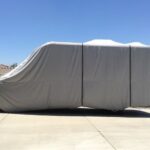This is a brief introduction to the fiberglass type of RV, intended to provide essential information for choosing the best RV type. (Looking for fiberglass RV Manufacturers?)
Not sure if this is the right RV type for you? Please take a look at our RV Types Pros & Cons Checklist.
What Is a Fiberglass Trailer?

Definition of a Fiberglass RV
A molded fiberglass RV is not a specific body type, like a Class A coach or a 5th wheel.
Instead, it’s a distinctive method of manufacturing.
Fiberglass trailers are from spray open-molded or cast closed-molded fiberglass fabrication processes. The camper bodies are assembled from just 1, 2, or 3 pieces.
The final assembled hull is lightweight, watertight, easy to clean, and very durable.
Classic fiberglass trailers are small travel trailers. However, you can get them in many different body types:
- Travel trailers
- Teardrop and mini campers
- 5th wheels
- Slide-in truck campers
Molded fiberglass campers are not available as motorhomes or coaches.
Unlike motorhomes like Class C motorhomes and conversion vans, you tow a fiberglass trailer. And no, you don’t generally need a special license to tow one!
Fiberglass RV Specifications
Dimensions
- Lengths range from 10 to 25 feet, with 12 to 18 feet being the most common.
- Width ranges from 6 ft to 8 ft, with 6.5 to 7 feet being standard.
- Height varies from 6 to 9.75 feet, with most ranging between 7 and 8.5 feet (rooftop A/C included).
Driving an RV for the first time? Check out our guide to what you need to know about length, width, height, and weight!
Sleeping Capacity
Most fiberglass RVs can fit 1-6 sleepers (2-4 standard). You’d be surprised how roomy one of these campers is! They’re like clown cars.
Fiberglass RV Categories
Molded fiberglass campers are widely split into two/two subsets:
- 1-piece/2-piece
- Single-wall hull/double-wall hull
Single-piece molded fiberglass campers, like the Little Guy MyPod, are made using close-molded fiberglass casting processes. The body is one single, seamless piece – nor joints anywhere!
Most fiberglass campers are 2-piece designs, typically with a top and a bottom fastened at the mid-seam. This fabrication method is much easier to design, build and scale.
Also, most fiberglass campers have single-wall hulls. This means the wall is a single thick piece of fiberglass. There are no cavities for wiring or insulation.
A few RV manufacturers produce double-wall hulls. These are constructed more like boats than RVs! Essentially, an inner hull is nested inside an outer hull, like a Russian nesting doll. The space between is used for mechanicals and insulation.

Fiberglass RV Description
Most RVs are built using one of two types of construction:
- Stick n’ tin
- Laminated fiberglass
In both of these styles, the RV body is assembled from smaller pieces. In the example of a fiberglass laminate camper, the body is assembled from a subfloor, laminated walls, and either a cage roof or ceiling trusses, with a roof skin pulled over the top.
In contrast, a molded fiberglass camper is built like a plastic Easter Egg.
Two fiberglass halves – usually a top and bottom – are molded using spray open-molded or cast close-molded fiberglass fabrication methods. Then, the two halves are fastened together to form a two-piece “hull.”
Most fiberglass RVs, like Scamp, Nest by Airstream, and Casita, are small travel trailers.
Fiberglass RV Chassis & Fuel Economy
Fiberglass campers have been popular since the 1970s. For one, they’re adorable! Secondly, they are small (fun-sized) and lightweight. The Scamp 13, for instance, has a dry weight as low as 1,200 pounds!
If you will be towing with a smaller towing vehicle, like a crossover SUV or compact pickup truck, a fiberglass travel trailer is a great choice.
Virtually all molded fiberglass campers are built on custom chassis frames. Compared to conventional travel trailers, fiberglass campers are sold in low volumes, so every manufacturer designs and/or produces their own chassis.
Because these RVs have solid fiberglass campers, the usual mechanical innards in the RV underbelly, such as water tanks, are either mounted inside the unit or exposed to the road within the frame rails. Units with tanks inside the interior are 3.5-season campers and can be used in frigid temperatures; units with exposed water tanks cannot be fully used in winter.
Fuel economy will be based on the size and horsepower of your tow vehicle compared to the size and weight of your towable RV.
- Average Fuel Economy loss, travel trailer: Expect 2-4+ mpg loss (the smaller the tow vehicle, the bigger the loss)
- Average Fuel Economy loss, 5th wheel: Expect 3-6+ mpg loss (the smaller the tow vehicle, the bigger the loss)
Who Might Want a Fiberglass RV?
People who like fiberglass RVs … loooove them.
Lightweight, maneuverable, waterproof, easy maintenance, good resale value – what’s not to love? They are easy to park, drive and store.
You might be surprised to learn how many campers live full-time in their egg-shaped fiberglass campers. No, they don’t have the lounge space or amenities of a Class A coach. And they can be claustrophobic after days of rain or snow. But they can go just about anywhere!
Fiberglass campers are a great fit for a person who enjoys minimalism and adventure. Most comfortably sleep 2, or 3 in a pinch. Some larger models, such as several Bigfoot campers, can sleep up to 4, or 5 in a pinch.
Most fiberglass RVs have bathrooms with a shower and toilet. The smallest have combined wet baths, but most, such as the travel trailers from Casita, have separated dry baths.
Fiberglass RV Pros and Cons
PROS
- Lightweight!
- Easy to clean, inside and out.
- Holds their resale value.
- Waterproof, seamless exterior.
- Aerodynamic, good for fuel efficiency.
- Tow vehicle doubles as local transportation.
- Lower profile allows easier entry than any other camper.
- Can normally be stored in a garage or under a carport.
CONS
- Limited interior lounge and storage space
- Small refrigerators, cramped bathrooms
- Limited to tents and awnings for living area expansion. No slide-outs.
- Less storage than other types of campers.
- You gotta keep the inside clean – people always want to look inside!
Key Features in a Fiberglass RV
Model Type
The first decision is what style of RV do you want? Check out our other guides to RV model types to choose the style that’s best for you!
Size and Space
Let’s take a look at three common sizes of molded fiberglass travel trailers.
This is a layout from Scamp for its 13-foot travel trailer. Everything you need, nothing you don’t. Just a convertible dinette, kitchenette, storage, and wet bathroom. Great for one (or two travelers deeply in love).

If you want a little more space, why not check out this Casita 17-ft camper? It has a convertible dinette that can be left as a fixed full-size bed, a larger kitchen, and a dry bath.

If you want the usual RV experience in a fiberglass package, you can checkout the 2500 Travel Trailer series from Bigfoot. This particular layout has dual twin beds, a 3/4 dry bath, full-size refrigerator, convertible dinette, and full-length wardrobe closets. If you’re considering traveling in your RV full-time, this could be a great choice!

4-Season or Not?
For some reason (don’t ask me), many buyers of fiberglass RVs are interested in winter camping or full-timing.
In fact, there’s a whole forum on the topic at FiberglassRV.com.
Brands like Oliver, Escape, and Bigfoot specialize in 3.5- or 4-season design.
Sleeping and Seating Questions
Sleeping
- What size of bed (twin, full, queen, short queen, king) do I need?
- Am I going to sleep in the same bed as my partner, or will we need dual twin beds?
- Can we scoot to the end of a bed, or do we need to roll off the side?
- How much visual or acoustic privacy do we need? Will a curtain suffice, or a solid wall and a door?
- Do we need a TV in our bedroom?
- Do we need an adjacent master bath?
- Do we need a full-size bed for kids or guests, or will a murphy, sofa or bunk bed do the trick?
Seating
- Where will we eat breakfast, lunch and dinner? Do we need a breakfast nook in addition to the main living area?
- Do we need a separate table for office space?
- How many people need to be able to watch TV or eat a meal at once?
Fiberglass RV Major Manufacturers
There are about 12 major fiberglass RV manufacturers in North America.
Some of the biggest names include:
- Casita
- Scamp
- Bigfoot
- Northern Lite
- Escape
- Oliver
- Armadillo
For a full list of manufacturers, check out our comprehensive RV manufacturer’s list!
We’ve spotlighted a few brands below. These brands are either known for their popularity, quality, or innovation.
Scamp

Scamp Trailers is an RV manufacturer based in the state of Minnesota and has been in operation since 1971. The company is owned by EVELAND’S.
A classic molded fiberglass camper, the 13, 16 and 19-ft Scamps are sold factory direct and are known for holding their value (and cuteness).
Oliver
![]()
Oliver Travel Trailers is an RV manufacturer based in the state of Tennessee and has been in operation since 2007. The company is owned by private ownership or family.
Oliver produces two-piece fiberglass travel trailers known for their impeccable engineering and high resale value. They build one of the few double-hulled fiberglass RVs in the world!
Bigfoot Industries
Bigfoot Industries is an RV manufacturer based in the province of British Columbia and has been in operation since 1989/2010. The company is owned by private ownership or family.
Canadian manufacturer of two-piece fiberglass truck campers – one of the very few! – and travel trailers serving Canada, Alaska, and the West Coast.
Bigfoot campers are a favorite for travelers looking for true 4-seaeson designs. It’s also one of the few manufacturers of a fiberglass 5th wheel.
Northern Lite

Northern Lite is an RV manufacturer based in the province of British Columbia and has been in operation since 1989. The company is owned by private ownership or family.
Designed for the northern wilds, Northern Lite builds 4-season, lightweight, 2-piece fiberglass truck campers. They are a favorite choice for customers searching for that elusive molded fiberglass, full-size truck camper!
Fiberglass RV FAQs
Yes!
Of all RV types, fiberglass models may do the best in 24/7 exposure. Due to their lightweight, small strength and monocoque shell strength, they can handle rough conditions. Plus, you’re less likely to get bogged down in mud or sand!
However, most fiberglass RVs don’t have great ground clearance. You may need to flip the axle or add in lift blocks for rougher terrain.
Most of the appliances aboard a smaller fiberglass RV don’t draw as much power as their full-size equivalents. However, you may need to add additional propane tanks or upgrade your battery bank size to run off-grid for extended time periods.
No. Generally, you cannot “triple-tow” with a travel trailer. Even states that allow triple-towing generally do not allow it with a camper trailer because of maximum motorcade length and weight restrictions.
However, you can just use your tow vehicle as your daily driver!
Many fiberglass RVs can be towed with regular passenger cars! Some can be towed with vehicles rated for as little as 2,000 pounds, but most are best towed with CUVs, SUVs, or small pickup trucks rated for 3,500 pounds or more.
To help you answer this question, please took a look at these two resources:
Related RV Checklists
The following RV checklists on our website are applicable to fiberglass RVs:









